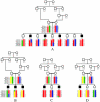Homozygosity mapping in families with Joubert syndrome identifies a locus on chromosome 9q34.3 and evidence for genetic heterogeneity
- PMID: 10577920
- PMCID: PMC1288377
- DOI: 10.1086/302655
Homozygosity mapping in families with Joubert syndrome identifies a locus on chromosome 9q34.3 and evidence for genetic heterogeneity
Abstract
Joubert syndrome is a rare developmental defect of the cerebellar vermis, with autosomal recessive inheritance. The phenotype is highly variable and may include episodic hyperpnea, abnormal eye movements, hypotonia, ataxia, developmental delay, and mental retardation. Even within sibships the phenotype may vary, making it difficult to establish the exact clinical diagnostic boundaries of Joubert syndrome. To genetically localize the gene region, we have performed a whole-genome scan in two consanguineous families of Arabian/Iranian origins, with multiple affected probands. In one family, we detected linkage to the telomeric region of chromosome 9q, close to the marker D9S158, with a multipoint LOD score of Z=+3.7. The second family did not show linkage to this region, giving a first indication of genetic heterogeneity underlying Joubert syndrome. These findings were supported by subsequent analysis of two smaller families-one compatible with linkage to 9q; the other, unlinked. We conclude that Joubert syndrome is clinically and genetically heterogeneous and that one locus maps to chromosome 9q.
Figures



References
Electronic-Database Information
-
- Généthon, http://www.genethon.fr (for information on microsatellite markers)
-
- Online Mendelian Inheritance in Man (OMIM), http://www.ncbi.nlm.nih.gov/Omim (for Joubert syndrome [MIM 213300])
References
-
- Boltshauser E, Isler W (1977) Joubert syndrome: episodic hyperpnea, abnormal eye movements, retardation and ataxia, associated with dysplasia of the cerebellar vermis. Neuropaediatrie 8:57–66 - PubMed
-
- Dib C, Faure S, Fizames C, Samson D, Drouot N, Vignal A, Millasseau P, et al (1996) A comprehensive genetic map of the human genome based on 5,264 microsatellites. Nature 380:152–154 - PubMed
-
- Hatten ME, Heintz N (1995) Mechanisms of neural patterning and specification in the developing cerebellum. Annu Rev Neurosci 18:385–408 - PubMed
-
- Joubert M, Eisenring JJ, Robb JP, Andermann F (1969) Familial agenesis of the cerebellar vermis. A syndrome of episodic hyperpnea, abnormal eye movements, ataxia, and retardation. Neurology 19:813–825 - PubMed
Publication types
MeSH terms
Substances
LinkOut - more resources
Full Text Sources

